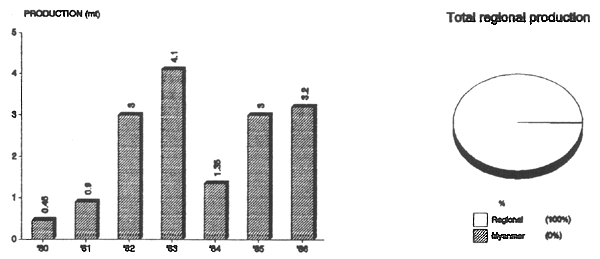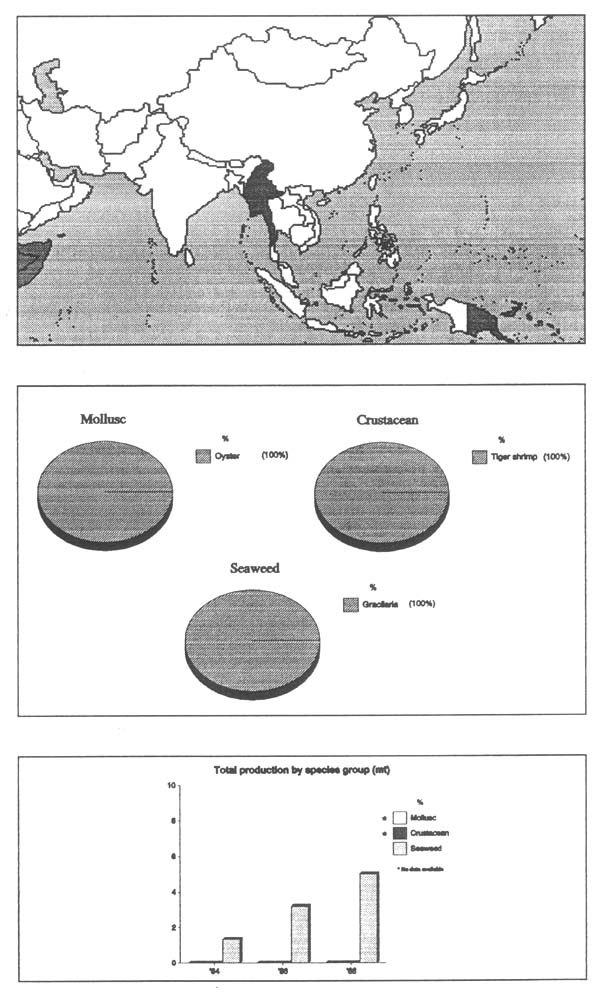
CRASSOSTREA spp., SACCOSTREA spp.
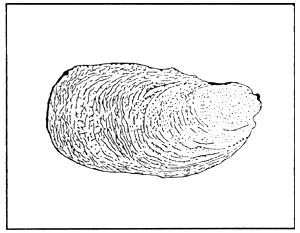
HISTORY
Aquaculture in Myanmar was initiated in late 1950 while freshwater aquaculture gained momentum only in the 1970s. On the other hand, mariculture has been neglected. Recently, however a number of research investigations regarding mariculture have been conducted by several institutions, which revealed great developmental potentials in this sector of the aquaculture industry. Among the potential seafarming species identified, oysters rank among the first in the mollusc list. Several species of edible oyster have been reported from Rakhine and Tanintharyi coastal areas. The demand for these bivalves comes only from local consumers, a demand which is very low compare to the abundant natural resources. Experimental culture trials on several oyster species (Crassostrea belcheri and Saccostrea cucullata) were initiated in 1974 and encouraging results have been obtained since. At present a small-scale oyster farm has been established in Rakhine State. The major constraints for the expansion of the industry are lack of culture and processing technologies. Despite efforts exerted by the Department of Fisheries, through extension and demonstration activities, the coastal communities remain rather reluctant to venture into any consistent project. As a result, the industry is still poorly developed. Other possible major constraints include the limited demand for seafarming organisms, low prices and the many marketing restrictions. To cope with the urgent need to develop the industry, the Department of Fisheries plans to establish 3 seafarming research cum extension stations in each coastal region. These stations will have specific objectives among which will be the development of suitable techniques for culturing of molluscs.
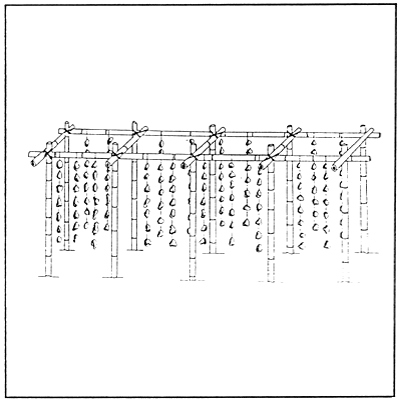
CULTURE PRACTICES
In the oyster culture experiments, the hanging stake method was used for spat collection while floating and fixed raft were used for nursery and culture to market size. The experimental culture sites were flat muddy intertidal areas. Several kinds of cultches have been used and tested for the collection of oyster spat, among which are asbestos sheets, fragments of coconut shells and empty adult oyster shells. The culth or collector strings are hanged from a bamboo stake frame hoisted at a depth of about 2.5 metres. The collectors are spaced at regular intervals of about 25–30 cm. The culth are usually 2 metres long and 70–80 collectors are tied to a hanging galvanized wire or nylon string. When the collectors are covered with the desirable number of oyster spats the culth strings are removed and attached to floating rafts, placed in waters 3–5 metres deep, or onto fixed bottom racks (7×2 m). The time of spat collection varies according to the locality, however it has been reported that a major peak season occurs between December to March. The floating rafts are made of bamboo poles and are moored to the four corner posts with enough slack to allow the raft to float at different water levels. During the harvesting process, the oyster lines are merely untied from the bamboo poles and hauled to a raft or small boat. The bottom racks are usually made of six bamboo poles firmly embedded into a soft substratum. The poles sustain a tray onto which the oyster spat-bearing cultches are placed. Oyster culture in Myanmar is still in the initial stages of development and there are a considerable number of problems to be resolved before the commercial culture of oysters can be carried out. Further research into adapting established culture methods and techniques from countries in the region will certainly help towards the commercial propagation of oysters in Myanmar. It is believed that the oyster industry in Myanmar will certainly expand in the future as there is plenty of room for expansion, labour is still cheap, and foreign markets remain unsaturated or untapped. It is also hoped that the new government policy towards aquaculture development will speed up the process.
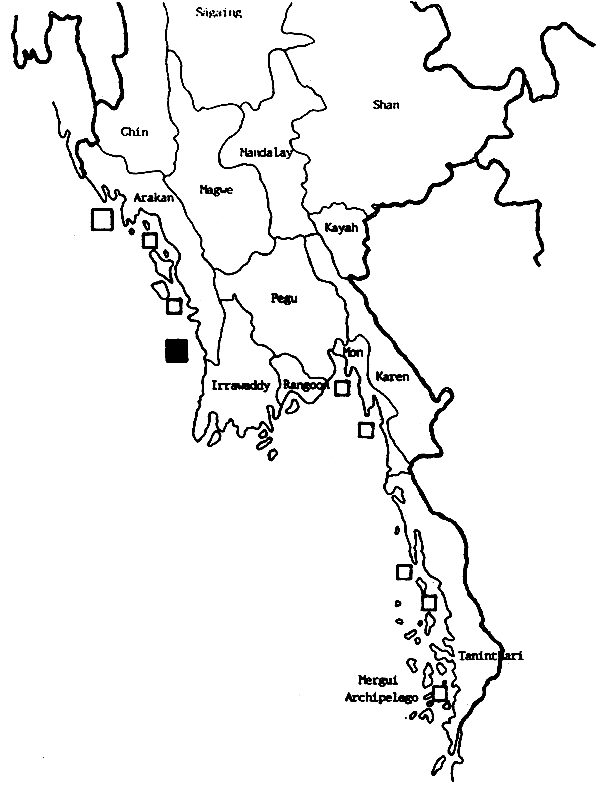
| STATUS | SPECIES |
|---|---|
| C. belcheri and C. cucullata | |
| Source of seed | Wild |
| Culture method | Suspended (raft & stake) |
| Yield/ha | NA |
| Marketing | Domestic |
| Production area | NA |
| Level of culture | Experimental |
| Major constraints | Limited seed supply; Poor culture techniques |

PENAEUS spp.
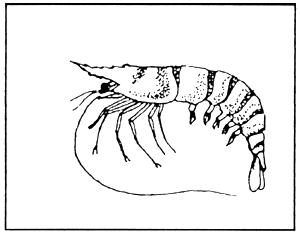
HISTORY
Aquaculture in Myanmar was initiated in late 1950 and freshwater aquaculture gained momentum in the 1970s. On the other hand, mariculture has been neglected. Recently, however a number of research investigations on mariculture have been conducted by several institutions, which revealed great developmental potential in this sector of the aquaculture industry. However, despite efforts exerted by the Department of Fisheries, through extension and demonstration activities, the coastal communities remain rather reluctant to venture into any consistent project. As a result, the industry is still poorly developed. This situation changed in 1988. The State Law and Order Restoration Council, with an aim of ensuring greater involvement of the private sector, introduced an open-door market economy. As a result, the role of private enterprises has been highly encouraged, with a noticeable increase in production and trade. Over 12,000 acres of tidal waste land have been transformed into shrimp farms. In addition to the incentives provided by the government, another factor which is responsible for the growth of mariculture in this area, is the high shrimp market value, even though the yield per unit area remains low. As a result, coastal communities are requesting government assistance to acquire advanced shrimp culture technology in order to increase production. Penaeid shrimp are widely distributed in the coastal waters of Myanmar. Among them Penaeus monodon, P. indicus, P. semisulcatus and P. merguiensis are the most popular marine shrimps in the local market and for export. Farming of P. monodon started 15 years ago in Rakhine State. Planning and implementation of hatcheries and culture farms are currently in progress.
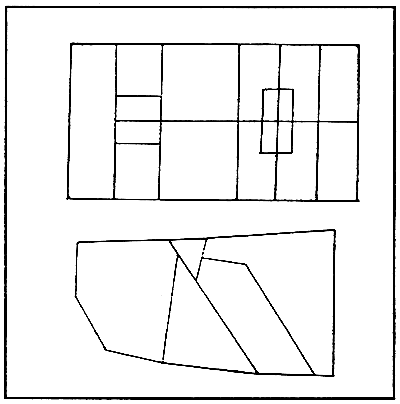
CULTURE PRACTICES
The first serious attempts to culture tiger shrimp started 15 years ago using the age old traditional trap and holding method. Seed supply was entirely derived from the wild. Experimental culture trials using more sophisticated and modern techniques were first conducted in 1984. The seeds were initially collected from wild as hatchery reared post-larvae were produced only in 1988. Initially, extensive and semi-intensive culture practices were experimented with in Naukme Pilot shrimp farm. Post-larvae collected from the wild were stocked into experimental ponds from 1984–1987. Due to the scarcity of good quality seeds and the lack of technical knowledge and expertise, the production rates were very low. In 1987, a pilot shrimp hatchery was established at Thandwe in Rakhine State. One of the main aspects in hatchery production of seeds is the availability of sexually mature individuals which can be readily spawned. At present, these are obtained entirely from the wild. Experiments to induce maturation in adult specimens have not been successful. After using the hatchery reared shrimp seeds the survival rate improved to 30% and a production rate of 0.5 tonnes/ha was achieved. Due to the encouraging results, shrimp grow-out farms are presently being constructed in numerous coastal areas. At present shrimp culture is mostly extensive and semi-intensive. No feed is provided other than naturally occurring pond organisms, rice bran, soy bean and peanut cakes. Recently trash fish has became a major food source. Shrimp formulated feeds are becoming increasingly popular, however they are not extensively available in Myanmar due to the shortage of processing techniques and facilities. The culture ponds are generally 1–5 ha in size, with earthen dikes and sand or clay bottoms. Water exchange is accomplished by natural tidal fluctuation. Air blowers and paddle wheels are not so popular. Myanmar is not a main producer of marine shrimp in the region, however it possesses great potential. The key for developing this industry is the rapid introduction of advanced hatchery techniques, development of farming methods and formulation of feeds.
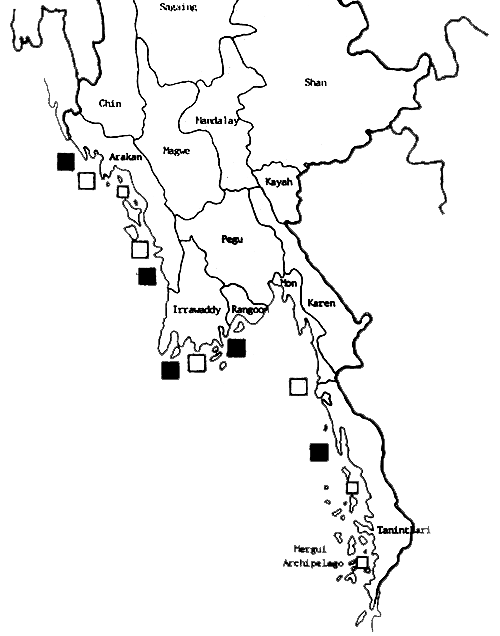
| STATUS | SPECIES |
|---|---|
| Penaeus monodon | |
| Source of seed | Artificial and wild |
| Culture method | Pond |
| Yield/ha | 300–500 kg/ha |
| Marketing | Domestic and export |
| Production area | NA |
| Level of culture | Developing |
| Major constraints | Poor hatchery & culture techniques; Poor feed quality |

GRACILARIA EDULIS
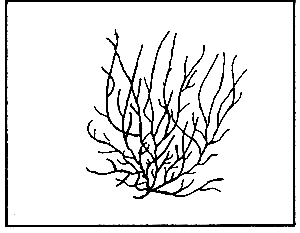
HISTORY
Myanmar, having a long coast line of 2,832 km with many rivers flowing into the extended and large continental shelf of 228,781 km2, is rich in natural fishery resources. These resources include not only fin and shell fishes but also seaweeds which are commonly found washed up on the beaches. There are ten genera of red algae, four of brown algae and eight of green algae in the country. Statistics on seaweed production are not readily available, but the Marine Biological Department of Moulmein University and Myanmar Foodstuff Industries estimate that at least 1,500 tons of dried raw seaweed are produced in Myanmar each year. Production comes mainly from Enteromorpha (@ 5 tonnes dry wt), Catenella (@ 30 tonnes dry wt), Sargassum (@ 1,000 tonnes dry wt) and Hypnea (@ 400 tonnes dry wt). Seaweeds have been consumed traditionally as salad. Since the market is limited in the coastal areas and the harvest from the natural grounds exceed the local demand, farming of the seaweeds has been neglected for a long time and is still on an experimental scale up to very recent. Out of many species of seaweeds, G. edulis is the only one utilized for culture. The research on culture methods of G. edulis, the most readily available and popular seaweed species, was first attempted in 1974 at Setsei in Mon State and a pilot scale farm was established in 1979 at Thandwe (Sandoway) in Rakhine State. At present, it is felt that experiments should be carried out to find more uses of the seaweed species which are currently not commercially utilized. Experiments should also be done on culture techniques so that the ones that are better suited to the condition of the country can be used in commercial ventures.
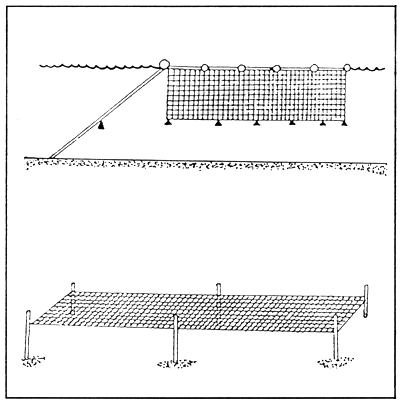
CULTURE PRACTICES
Two culture methods are practiced i.e. open sea and pond culture. Culture sites are chosen where the salinity ranges between 25–32 ppt. The open sea culture method was first carried out at Maung Shwe Lay Bay in Rakhine State, using the vertical constant length long-line floating system. The total length of one net-line system is approximately 50 metre. In one net long-line system, 50 floats are used. The diameter of the rope ranges between 8–12 mm. Concrete blocks weighing 16 kg or iron anchor, are used to anchor the net-line system. Nylon nets woven 18-ply and measuring 5×10 m with a net aperture of 13 cm are used. In this system, a total of 10 nets are attached to one line, and in experimental trial 30–90 long-lines are used. The pond culture method was first carried out using four bamboo poles fixed to the bottom in the shape of a square. The nets are attached to these poles so that they also assume a square shape.
The nets are usually placed 0.3 metres above the bottom of the pond. Initially, G. edulis seed plants for the culture trials were collected from Mawtin Point, Ngaputaw township and transported to the site within 36 hours. Recently, seed plants of the same species have been collected from Andrew Bay only about 7 miles from Maung Shwe Lay Bay. The seed plants are collected fortnightly during the season, lasting from February-April, and carried in baskets and planted immediately on arrival at the culture site. The seed plants collected from various parts of the coast are immediately cut into 5–7 cm fragments and tied to the cross-sections of the nets with thin plastic strings. The seaweeds are initially harvested 60 days after seeding, after which harvesting is carried out every 30 days. At every harvest, ⅓ of the plant is left as a seed plant. Harvesting is carried out manually. During the cultivation period, the net-line systems and plants have to be maintained regularly to minimize weatherinfluenced damage and that caused by marine animals such as fish, crab and molluscs. Harvested seaweeds are washed and cleaned. Cleaned seaweeds are then dried on bamboo screens in the sun for a day or more depending on weather conditions.
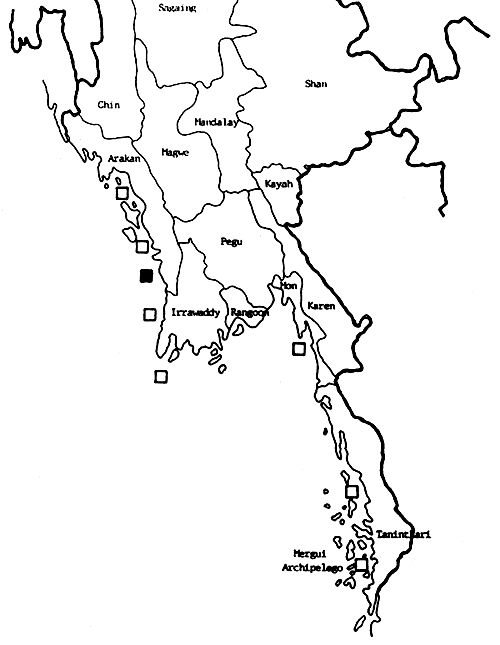
| STATUS | SPECIES |
|---|---|
| Gracilaria edulis | |
| Source of seed | Wild |
| Culture method | Open sea and pond |
| Yield/ha | 120–360 kg/long-line net/season (5 harvests) (wet wt) |
| Marketing | Domestic |
| Production area | NA |
| Level of culture | Experimental |
| Major constraints | Lack of culture and processing technologies |
